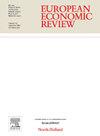Pro-cyclical emissions, real externalities, and optimal monetary policy
IF 2.4
2区 经济学
Q1 ECONOMICS
引用次数: 0
Abstract
We study optimal monetary policy in an analytically tractable New Keynesian DSGE-model with an emission externality. Empirically, emissions are strongly pro-cyclical and output in the flexible price equilibrium overreacts to productivity shocks, relative to the efficient allocation. At the same time, output under-reacts relative to the flexible price allocation due to sticky prices. Therefore, it is not optimal to simultaneously stabilize inflation and to close the natural output gap, even though this would be feasible. Real externalities affect the LQ-approximation to optimal monetary policy and we extend the analysis of Benigno and Woodford (2005) to inefficient flexible price equilibria. For central banks with a dual mandate, optimal monetary policy places a larger weight on output stabilization and targets a non-zero natural output gap, implying a higher optimal inflation volatility.
顺周期排放、实际外部性和最优货币政策
我们在一个具有排放外部性的新凯恩斯dsge模型中研究最优货币政策。从经验上看,相对于有效配置,排放具有很强的顺周期性,灵活价格均衡中的产出对生产率冲击反应过度。与此同时,由于粘性价格,相对于灵活的价格分配,产出反应不足。因此,同时稳定通胀和缩小自然产出缺口并不是最优的,尽管这是可行的。实际外部性影响最优货币政策的lq近似,我们将贝尼尼奥和伍德福德(2005)的分析扩展到低效的灵活价格均衡。对于具有双重使命的央行来说,最优货币政策更重视产出稳定,并以非零的自然产出缺口为目标,这意味着更高的最优通胀波动性。
本文章由计算机程序翻译,如有差异,请以英文原文为准。
求助全文
约1分钟内获得全文
求助全文
来源期刊

European Economic Review
ECONOMICS-
CiteScore
4.70
自引率
3.60%
发文量
170
期刊介绍:
The European Economic Review (EER) started publishing in 1969 as the first research journal specifically aiming to contribute to the development and application of economics as a science in Europe. As a broad-based professional and international journal, the EER welcomes submissions of applied and theoretical research papers in all fields of economics. The aim of the EER is to contribute to the development of the science of economics and its applications, as well as to improve communication between academic researchers, teachers and policy makers across the European continent and beyond.
 求助内容:
求助内容: 应助结果提醒方式:
应助结果提醒方式:


